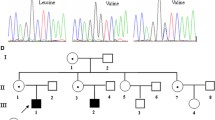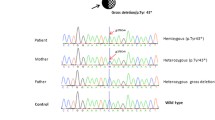Abstract
Background
X-linked agammaglobulinemia (XLA) is a severe, life-threatening disease characterized by failure of B cell differentiation and antibody production and is associated with mutations in Bruton’s tyrosine kinase (Btk). The proband in this study is a 51-year-old male presenting with chronic nasal congestion, recurrent sinusitis, sporadic pneumonia, and pronounced B cell deficiency. A family history suggestive of an X-linked immunodeficiency disease was noted.
Materials and Methods
cDNA was synthesized from mRNA prepared from peripheral blood mononuclear leukocytes. Btk cDNA amplified by polymerase chain reaction (PCR) was subjected to both manual and automated DNA sequencing. A DNA sequence corresponding to exons 6 and 7 of Btk was amplified from genomic DNA. Western blot analysis employed both polyclonal and monoclonal antibodies to Btk and reaction patterns were obtained both by chemiluminescence and an in vitro kinase assay.
Results
A mutation (Cys145→stop) was identified in Btk cDNA and was confirmed in amplified exon 6 of genomic DNA from both the proband and an affected nephew. Neither Btk nor a truncated peptide was detected in Western blot analyses of peripheral blood mononuclear cell lysates.
Conclusions
The C145A mutation reported here is novel. This family study is extraordinary in that affected male members who did not undergo aggressive medical management either succumbed to complications in early life or survived into later life. The proband is the oldest de novo diagnosed patient with XLA reported to date.



Similar content being viewed by others
References
Bruton OC. (1952) Agammaglobulinemia. Pediatrics 9: 722–728.
Rosen FS, Cooper MD, Wedgwood RJP. (1984) The primary immunodeficiencies. N. Engl. J. Med. 311: 235–242.
Lederman HM, Winkelstein JA. (1985) X-linked agammaglobulinemia: An analysis of 96 patients. Medicine 64: 145–156.
Tsukada S, Saffran DC, Rawlings DJ, et al. (1993) Deficient expression of a B cell cytoplasmic tyrosine kinase in human X-linked agammaglobulinemia. Cell 72: 279–290.
Vetrie D, Vorechovsky I, Sideras P, et al. (1993) The gene involved in X-linked agammaglobulinaemia is a member of the src family of protein-tyrosine kinases. Nature 361: 226–233.
Vihinen M, Iwata T, Kinnon C, et al. (1996) BTKbase, mutation database for X-linked agammaglobulinemia (XLA). Nucleic Acids Res. 24: 160–165.
Bykowsky MJ, Haire RN, Ohta Y, et al. (1996) Discordant phenotype in siblings with X-linked agammaglobulinemia. Am. J. Hum. Genet. 10: 477–483.
Ohta Y, Haire RN, Litman RT, et al. (1994) Genomic organization and structure of the Bruton agammaglobulinemia tyrosine kinase: Localization of mutations associated with varied clinical presentations and course in X chromosome-linked agammaglobulinemia. Proc. Natl. Acad. Sci. U.S.A. 91: 9062–9066.
Sideras P, Smith CIE. (1995) Molecular and cellular aspects of X-linked agammaglobulinemia. Adv. Immunol. 59: 135–223.
Saffran DC, Parolini O, Fitch-Hilgenberg ME, et al. (1994) Brief report: A point mutation in the SH2 domain of Bruton’s tyrosine kinase in atypical X-linked agammaglobulinemia. N. Engl. J. Med. 330: 1488–1491.
Leickly FE, Buckley R. (1986) Variability in B cell maturation and differentiation in X-linked agammaglobulinemia. Clin. Exp. Immunol 65: 90–99.
Wedgwood RJ, Ochs HD. (1980) Variability in the expression of X-linked agammaglobulinemia: The co-existence of classic XLA (Bruton type) and “common variable immunodeficiency” in the same families. In: Seligmann M, Hitzig WH (eds). Primary Immunodeficiencies. INSERM Symposium No. 16. Elsevier/North-Holland Biomedical Press, The Netherlands, pp. 69–78.
Kornfeld SJ, Kratz J, Haire RN, et al. (1995) X-linked agammaglobulinemia presenting as transient hypogammaglobulinemia of infancy. J. Allergy Clin. Immunol. 95: 915–917.
Acknowledgments
We would like to thank Barbara Pryor for her editorial assistance and Drs. M. Berger and D. Friedman for sharing clinical information and assistance in obtaining peripheral blood samples from family members. This work was supported by grants from the Eleanor Naylor Dana Charitable Trust and the Valerie Fund to GWL, and National Institutes of Health Grant CA34546 to SMF.
Author information
Authors and Affiliations
Rights and permissions
About this article
Cite this article
Kornfeld, S.J., Haire, R.N., Strong, S.J. et al. A Novel Mutation (Cys145→Stop) in Bruton’s Tyrosine Kinase Is Associated with Newly Diagnosed X-Linked Agammaglobulinemia in a 51-Year-Old Male. Mol Med 2, 619–623 (1996). https://doi.org/10.1007/BF03401645
Published:
Issue Date:
DOI: https://doi.org/10.1007/BF03401645




